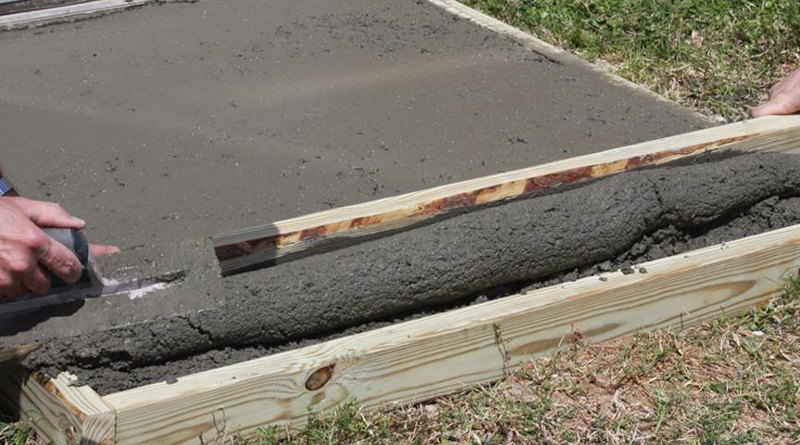Before erecting a shed, greenhouse or other small temporary building in your garden, you should definitely think about laying a concrete slab or pad for it to sit on.
This serves not only to give the shed/greenhouse a firm footing and a solid internal floor, but will also help to reduce moisture seeping up from the ground into the timber, and will help prolong the life of the building.
Concrete pads need to be different thicknesses depending on what is going to sit on them. For some guidance, have a look at our Guide to Concrete Pad Depths.
How to Lay a Concrete Slab
As with any DIY job, when laying a concrete slab, do your best to make sure that you have everything you need ready and at hand. For this job, you will need a shovel, spirit level, string, wood for the formwork, sand, cement and aggregate, and somewhere to mix it.
Marking and Digging Out
 Start by marking out the size of the area using strings and pegs knocked into the ground to form a rectangle.
Start by marking out the size of the area using strings and pegs knocked into the ground to form a rectangle.
Now remove a rectangle of turf or topsoil inside the strings to a depth of about 150mm. Extend the area outside of the string all the way around by another 100mm.
This extra margin will allow for the formwork (the wooden frame which will hold the wet concrete) to be added. If you are making your pad on a slope, make sure you keep the bottom of the hole level (using a spirit level laid across the hole in the direction of the slope), even if that means one side of the hole has an edge higher than 150mm.
Creating the Formwork
Your formwork should be made of lengths of 25mm thick timber which are at least as deep as the foundation hole (150mm) and held in place by 50mm x 50mm timber pegs. If your chosen site for the concrete pad is on a slope, you will need to take this into account when setting the formwork.
Start along the highest edge and, using the strings as a guide, fix the first plank of timber in place. The pegs should be on the outside of the plank.
Use a straight edge and a spirit level laid across the hole to find the level of the opposite plank, and using the strings as a guide again, fix this plank into place.
Fit the two end planks into place in the same way. You should now have a rectangular hole, lined with 25mm timber.
Laying a Hardcore Base
 Now you have your formwork in place, you need to start filling it. If the soil you are laying the pad on is very soft or has a high clay content, you may need to lay a layer of fine hardcore (crushed building rubble, stones, soil, etc).
Now you have your formwork in place, you need to start filling it. If the soil you are laying the pad on is very soft or has a high clay content, you may need to lay a layer of fine hardcore (crushed building rubble, stones, soil, etc).
Lay this to a depth of about 50mm and make sure it is well compacted. Be aware that you may need to dig the hole out slightly more to allow for this layer of hardcore.
Use a small garden roller or simply compact it with a spade.
Laying the Concrete
Using a general purpose concrete mix (1 cement, 2 sand, 3 course aggregate), start to fill the area inside the formwork. For more info on concrete mixes, read our Concrete Guide.
Spread out your concrete as you go and tamp it down with the edge of a board. Tap the sides of the formwork periodically to create a cleaner edge.
Continue to add layers of concrete until you reach the required depth. Ideally, this should be up to the level of the top of the formwork. Smooth off the surface with a wooden or plastic float, or use a the edge of a plank of wood that is longer than the width of the hole.
When working in cold weather, cover the pad with a clear plastic sheet to keep frost out and to stop the concrete drying out too quickly. If the concrete dries out too quickly, it will not set properly and may crack and crumble.
If it looks like it is drying out too quickly, spray it lightly with water to damp it down. Once it has set properly (which can take several days), you can remove the formwork and backfill the space around the edge with soil. The pad is now ready to take your chosen structure.







